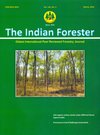Indigenous Method of Tapping Gum-Butea and its Impact on Livelihood of Saharia Tribe in Central India
DOI:
https://doi.org/10.36808/if/2016/v142i3/90957Keywords:
Kamarkas, Butea monosperma, Indigenous Knowledge, NTFP, Gum Tapping.Abstract
A study was conducted in Tikamgarh district in Bundelkhand region of Madhya Pradesh to document traditional techniques of tapping gum-butea and its impact on socioeconomic life of local Saharia inhabitants. The findings revealed that traditional method of collecting gum-butea followed by Saharias appears to have sound scientific basis. Yield of gum-butea was significantly correlated with tree girth (GBH) (r = 0.841; P≤0.01) and stem surface area (r = 0.804; P≤ 0.01). On an average, a tribal family earned ` 677 in a season which was not consistent across community (CV = 83.2%). Significant correlation existed between number of man-days employed and trees approached (r = 0.525, P = 0.01), total gum collected (r = 0.938; P≤0.01), and money earned (r = 0.774; P≤ 0.01). However, employment of more man-days did not yield proportional increase in collected gum. Trading process is traditional in nature and only limited outlets in the form of local pansaris (traders) and bichauliye (middle men) are available to gum collectors for selling their produce. The Saharias are compelled to sell gum-butea at low price (` 40 to 50 per kg). The study concluded that contribution of gum-butea in improving economic status of local tribes can be enhanced by removing inconsistency in making cuts on stem-bark and providing proper marketing channel.References
Ambasta B.P. (1994). The useful plants in India. CSIR, New Delhi. 1-91 pp.
Bhalla V. and Walter H. (1999). Research Bulletin of the Punjab University. Science, 48:87-94.
Chopra R.N., Chopra J.C., Handa K.L. and Kapur L.D. (1958). Indigenous drugs in India. Academic Publishers, Kolkata, India.
Gomez K.A. and Gomez A.A. (1984). Statistical Procedures for agricultural Research (II Eds) John Wley and Sons, Inc.
Jamal A. and Huntsinger L. (1993). Deterioration of a sustainable agro-silvo-pastoral system in the Sudan: the gum gardens of Kordofan. Agroforestry Systems, 23: 23-38.
http://www.haryana-online.com/Flora/dhak assessed on 21-09-2012
http://www.mpbd.info/plants/butea-monosperma.php assessed on 11-10-2012
Kirtikar, K.A. and Basu, B.D. (1935). Indian medicinal plants.Publishesd by Lalit Mohan Basu, Allahabad, India, 1&2: 785-788.
Mandal D. (1998). Social and economic sensario of a primitive tribe in Madhya Pradesh. In: Tribal Culture and Identity (Chaturbhuj Sahu, Ed.), Sarup & Sons Publication, New Delhi, pp. 236-243.
Mengi S.A. and Deshpande S.G. (1995).Comparative Evaluation of Butea Frondosa and Flurbiprofen for ocular anti-inflamatory Activity in Rabbits. Journal of Pharmacy and Pharmacology, 47: 997-1001.
Nadkarni K.M. (2002). Indian Materia Medica. Bombay Popular Prakashan, 1: 223-25.
Prabhu P. (1983). Social forestry: An adivasi viewpoint. In: Towards A New Forest Policy: People's Right and Environmental Needs (Walter Fernandes and Sharad Kulkarni, Eds.). Indian Social Institute,New Delhi
Prasad, R., Tripathi, V.D. and Dhyani, S.K. ( 2014). Scientific Insights of indigenous methods of collection gum-butea (kamarkas) and its impact on livelihood of Saharia tribe in Central India. In: Pratibha Bhatnagar (ed.). Gums and Resin Yielding Plants. Ponter Publishers, Jaipur (Rajasthan), India. pp. 111-123.
RCDC. (2006). Report on a Market Survey on Gums and Resins in India. Regional Centre for Development Co-operation, Centre for Forestry and Governance, Plot- N-4-342, IRC Village, Nayapalli Bhubaneswar-7, India
Samra J.S. (2008). Report on Drought mitigation strategy for Bundelkhand region of Uttar Pradesh and Madhya Pradesh. Inter - Ministerial Central Team, 144 pp.
Sindhia V.R.andBairwaR. (2010).PlantReview:Buteamonosperma. International JournalofPharmaceuticalandClinicalResearch,2(2):90-94.
Singh K.S. (1994). The Scheduled Tribes, Volume – III. Oxford University Press, Delhi
Ticktin T. (2004. The ecological implication of harvesting non-timber forest products. J. Applied Ecol., 41: 11-21.
Vaidyaratanam P. (1995). Indian Medicinal Plants. Orient Longman Publisher Madras, 1: 314.
Vandhan Vyapar (2012). Vandhan Vypar. Published State Forest Research Institute, Jabalpur. 12(3): 19.
Wagh V.V., Jain A.K. and Kadel Chitralekha (2010). Role of non-timber forest products in the livelihood of tribal community of Jhabua district (M.P.). Biologial Forum-An International Journal, 2(1): 45-48.
WilliamsV.I., Balkwill K. and Witkowski E.T.F. (2000). Unravelling the commercial market for medicinal plants and plant parts on the Wit waters and South Africa. Econ. Bot., 54(3): 310-327.
Downloads
Downloads
Published
How to Cite
Issue
Section
License
Unless otherwise stated, copyright or similar rights in all materials presented on the site, including graphical images, are owned by Indian Forester.





